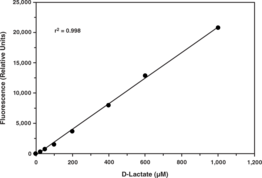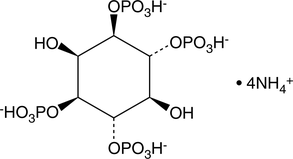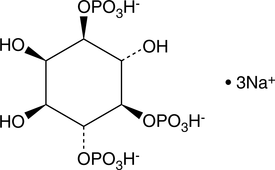Cayman
Showing 17101–17250 of 45550 results
-
D-Galactosamine is an amino sugar derivative of D-galactose (Item No. 20890). D-Galactosamine is hepatotoxic and is used, alone or in combination with LPS, as a model of liver failure in rodents.{41036,41037,41038}
Brand:CaymanSKU:22981 - 5 gAvailable on backorder
D-Galactose is a natural aldohexose and C-4 epimer of glucose. D-galactose is converted enzymatically into D-glucose for metabolism or polysaccharides for storage. Chronic, systemic exposure to D-galactose accelerates senescence in invertebrates and mammals and has been used as a model for aging.{33019} In bacteria, D-galactose is imported by a methyl-galactoside transport system to drive chemotaxis.{33018}
Brand:CaymanSKU:20890 -Out of stock
D-Galactose is a natural aldohexose and C-4 epimer of glucose. D-galactose is converted enzymatically into D-glucose for metabolism or polysaccharides for storage. Chronic, systemic exposure to D-galactose accelerates senescence in invertebrates and mammals and has been used as a model for aging.{33019} In bacteria, D-galactose is imported by a methyl-galactoside transport system to drive chemotaxis.{33018}
Brand:CaymanSKU:20890 -Out of stock
D-Galactose is a natural aldohexose and C-4 epimer of glucose. D-galactose is converted enzymatically into D-glucose for metabolism or polysaccharides for storage. Chronic, systemic exposure to D-galactose accelerates senescence in invertebrates and mammals and has been used as a model for aging.{33019} In bacteria, D-galactose is imported by a methyl-galactoside transport system to drive chemotaxis.{33018}
Brand:CaymanSKU:20890 -Out of stock
D-Galactose is a natural aldohexose and C-4 epimer of glucose. D-galactose is converted enzymatically into D-glucose for metabolism or polysaccharides for storage. Chronic, systemic exposure to D-galactose accelerates senescence in invertebrates and mammals and has been used as a model for aging.{33019} In bacteria, D-galactose is imported by a methyl-galactoside transport system to drive chemotaxis.{33018}
Brand:CaymanSKU:20890 -Out of stock
D-Glucosamine is an amino monosaccharide and a precursor in the biosynthesis of UDP-N-acetyl-D-glucosamine (UDP-GlcNAc; Item No. 20353) via the hexosamine pathway.{47389,47390} It increases mineralization of MC3T3-E1 mouse osteoblastic cells when used at concentrations of 0.1 and 1 mM.{47391} D-Glucosamine (20 mg/kg per day) inhibits bone erosion and loss of glycosaminoglycans and proteoglycans in joints in a mouse model of collagenase-induced osteoarthritis.{47390}
Brand:CaymanSKU:27055 - 100 gAvailable on backorder
D-Glucosamine is an amino monosaccharide and a precursor in the biosynthesis of UDP-N-acetyl-D-glucosamine (UDP-GlcNAc; Item No. 20353) via the hexosamine pathway.{47389,47390} It increases mineralization of MC3T3-E1 mouse osteoblastic cells when used at concentrations of 0.1 and 1 mM.{47391} D-Glucosamine (20 mg/kg per day) inhibits bone erosion and loss of glycosaminoglycans and proteoglycans in joints in a mouse model of collagenase-induced osteoarthritis.{47390}
Brand:CaymanSKU:27055 - 250 gAvailable on backorder
D-Glucosamine is an amino monosaccharide and a precursor in the biosynthesis of UDP-N-acetyl-D-glucosamine (UDP-GlcNAc; Item No. 20353) via the hexosamine pathway.{47389,47390} It increases mineralization of MC3T3-E1 mouse osteoblastic cells when used at concentrations of 0.1 and 1 mM.{47391} D-Glucosamine (20 mg/kg per day) inhibits bone erosion and loss of glycosaminoglycans and proteoglycans in joints in a mouse model of collagenase-induced osteoarthritis.{47390}
Brand:CaymanSKU:27055 - 500 gAvailable on backorder
D-Glucosamine-6-sulfate is a naturally occurring glycosaminoglycan.{39435} It activates the glmS ribozyme from B. subtilis, a Gram-positive bacterium, when used at a concentration of 200 µM.{40617} It has been used to form polyvalent dendrimer conjugates that inhibit angiogenesis and endothelial cell proliferation induced by FGF-2 in vitro and prevent scar tissue formation in a rabbit model of glaucoma surgery.{40618}
Brand:CaymanSKU:23097 - 10 mgAvailable on backorder
D-Glucosamine-6-sulfate is a naturally occurring glycosaminoglycan.{39435} It activates the glmS ribozyme from B. subtilis, a Gram-positive bacterium, when used at a concentration of 200 µM.{40617} It has been used to form polyvalent dendrimer conjugates that inhibit angiogenesis and endothelial cell proliferation induced by FGF-2 in vitro and prevent scar tissue formation in a rabbit model of glaucoma surgery.{40618}
Brand:CaymanSKU:23097 - 100 mgAvailable on backorder
D-Glucosamine-6-sulfate is a naturally occurring glycosaminoglycan.{39435} It activates the glmS ribozyme from B. subtilis, a Gram-positive bacterium, when used at a concentration of 200 µM.{40617} It has been used to form polyvalent dendrimer conjugates that inhibit angiogenesis and endothelial cell proliferation induced by FGF-2 in vitro and prevent scar tissue formation in a rabbit model of glaucoma surgery.{40618}
Brand:CaymanSKU:23097 - 250 mgAvailable on backorder
D-Glucosamine-6-sulfate is a naturally occurring glycosaminoglycan.{39435} It activates the glmS ribozyme from B. subtilis, a Gram-positive bacterium, when used at a concentration of 200 µM.{40617} It has been used to form polyvalent dendrimer conjugates that inhibit angiogenesis and endothelial cell proliferation induced by FGF-2 in vitro and prevent scar tissue formation in a rabbit model of glaucoma surgery.{40618}
Brand:CaymanSKU:23097 - 50 mgAvailable on backorder
D-Glucose-6-phosphate is formed in cells when glucose is phosphorylated by hexokinase (or glucokinase) or by the conversion of glucose-1-phosphate by phosphoglucomutase, which is the first step of glycogen synthesis.{20949} It is stored as glycogen when blood glucose levels are high. Disruption of D-glucose-6-phosphate activity leads to glycogen storage disease type I or von Gierke’s disease, a group of inherited metabolic diseases characterized by severe hypoglycemia, growth retardation, and hepatomegaly, due to accumulation of glycogen and fat in the liver.{19698,19697} D-Glucose-6-phosphate is also the starting molecule of both glycolysis and the pentose phosphate pathways.{19695} Because cancer cells adopt glycolysis as a major source of metabolic energy production, and the pentose phosphate pathway plays a role in helping glycolytic cancer cells to meet their anabolic demands, this compound can be used to study the progression of this process.{26683}
Brand:CaymanSKU:20376 -Available on backorder
D-Glucose-6-phosphate is formed in cells when glucose is phosphorylated by hexokinase (or glucokinase) or by the conversion of glucose-1-phosphate by phosphoglucomutase, which is the first step of glycogen synthesis.{20949} It is stored as glycogen when blood glucose levels are high. Disruption of D-glucose-6-phosphate activity leads to glycogen storage disease type I or von Gierke’s disease, a group of inherited metabolic diseases characterized by severe hypoglycemia, growth retardation, and hepatomegaly, due to accumulation of glycogen and fat in the liver.{19698,19697} D-Glucose-6-phosphate is also the starting molecule of both glycolysis and the pentose phosphate pathways.{19695} Because cancer cells adopt glycolysis as a major source of metabolic energy production, and the pentose phosphate pathway plays a role in helping glycolytic cancer cells to meet their anabolic demands, this compound can be used to study the progression of this process.{26683}
Brand:CaymanSKU:20376 -Available on backorder
D-Glucose-6-phosphate is formed in cells when glucose is phosphorylated by hexokinase (or glucokinase) or by the conversion of glucose-1-phosphate by phosphoglucomutase, which is the first step of glycogen synthesis.{20949} It is stored as glycogen when blood glucose levels are high. Disruption of D-glucose-6-phosphate activity leads to glycogen storage disease type I or von Gierke’s disease, a group of inherited metabolic diseases characterized by severe hypoglycemia, growth retardation, and hepatomegaly, due to accumulation of glycogen and fat in the liver.{19698,19697} D-Glucose-6-phosphate is also the starting molecule of both glycolysis and the pentose phosphate pathways.{19695} Because cancer cells adopt glycolysis as a major source of metabolic energy production, and the pentose phosphate pathway plays a role in helping glycolytic cancer cells to meet their anabolic demands, this compound can be used to study the progression of this process.{26683}
Brand:CaymanSKU:20376 -Available on backorder
D-glutamic acid is an amino acid and a component of bacterial peptidoglycan.{52869} It is linked to UDP-N-acetylmuramoyl-L-alanine (UDP-MurNAc-L-Ala) by the muramyl ligase MurD to form UDP-MurNAc-L-Ala-D-glutamic acid, a building block in the biosynthesis of bacterial peptidoglycan. D-glutamic acid is also a component of poly-γ-glutamic acid, a polymer produced by Bacillus.{52870}
Brand:CaymanSKU:31503 - 10 gAvailable on backorder
D-glutamic acid is an amino acid and a component of bacterial peptidoglycan.{52869} It is linked to UDP-N-acetylmuramoyl-L-alanine (UDP-MurNAc-L-Ala) by the muramyl ligase MurD to form UDP-MurNAc-L-Ala-D-glutamic acid, a building block in the biosynthesis of bacterial peptidoglycan. D-glutamic acid is also a component of poly-γ-glutamic acid, a polymer produced by Bacillus.{52870}
Brand:CaymanSKU:31503 - 100 gAvailable on backorder
D-glutamic acid is an amino acid and a component of bacterial peptidoglycan.{52869} It is linked to UDP-N-acetylmuramoyl-L-alanine (UDP-MurNAc-L-Ala) by the muramyl ligase MurD to form UDP-MurNAc-L-Ala-D-glutamic acid, a building block in the biosynthesis of bacterial peptidoglycan. D-glutamic acid is also a component of poly-γ-glutamic acid, a polymer produced by Bacillus.{52870}
Brand:CaymanSKU:31503 - 25 gAvailable on backorder
D-glutamic acid is an amino acid and a component of bacterial peptidoglycan.{52869} It is linked to UDP-N-acetylmuramoyl-L-alanine (UDP-MurNAc-L-Ala) by the muramyl ligase MurD to form UDP-MurNAc-L-Ala-D-glutamic acid, a building block in the biosynthesis of bacterial peptidoglycan. D-glutamic acid is also a component of poly-γ-glutamic acid, a polymer produced by Bacillus.{52870}
Brand:CaymanSKU:31503 - 50 gAvailable on backorder
D-Glutamine is an enantiomer of the non-essential amino acid L-glutamine (Item No. 23716). D-Glutamine levels are reduced in the serum of rats in a model of acute pancreatitis.{43939} Serum levels of D-glutamine are also reduced in patients with hepatocellular carcinoma.{43940}
Brand:CaymanSKU:27032 - 1 gAvailable on backorder
D-Glutamine is an enantiomer of the non-essential amino acid L-glutamine (Item No. 23716). D-Glutamine levels are reduced in the serum of rats in a model of acute pancreatitis.{43939} Serum levels of D-glutamine are also reduced in patients with hepatocellular carcinoma.{43940}
Brand:CaymanSKU:27032 - 10 gAvailable on backorder
D-Glutamine is an enantiomer of the non-essential amino acid L-glutamine (Item No. 23716). D-Glutamine levels are reduced in the serum of rats in a model of acute pancreatitis.{43939} Serum levels of D-glutamine are also reduced in patients with hepatocellular carcinoma.{43940}
Brand:CaymanSKU:27032 - 25 gAvailable on backorder
D-Glutamine is an enantiomer of the non-essential amino acid L-glutamine (Item No. 23716). D-Glutamine levels are reduced in the serum of rats in a model of acute pancreatitis.{43939} Serum levels of D-glutamine are also reduced in patients with hepatocellular carcinoma.{43940}
Brand:CaymanSKU:27032 - 5 gAvailable on backorder
D-Kynurenine is an antagonist of hydroxycarboxylic acid receptor 3 HCA3/GPR109B (EC50 = 2.61 µM in a luciferase reporter assay) and a metabolite of D-tryptophan.{46426} It increases levels of intracellular calcium and decreases forskolin-stimulated production of cAMP in CHO cells expressing human HCA3/GPR109B when used at concentrations of 10 and 100, or 1,000 µM, respectively. D-Kynurenine (10 µM) increases expression of vimentin and decreases expression of E-cadherin in 95D lung cancer cells.{46427} It has been used as a substrate in fluorometric assays for D-amino acid oxidase activity.{46428,46429}
Brand:CaymanSKU:28254 - 100 mgAvailable on backorder
D-Kynurenine is an antagonist of hydroxycarboxylic acid receptor 3 HCA3/GPR109B (EC50 = 2.61 µM in a luciferase reporter assay) and a metabolite of D-tryptophan.{46426} It increases levels of intracellular calcium and decreases forskolin-stimulated production of cAMP in CHO cells expressing human HCA3/GPR109B when used at concentrations of 10 and 100, or 1,000 µM, respectively. D-Kynurenine (10 µM) increases expression of vimentin and decreases expression of E-cadherin in 95D lung cancer cells.{46427} It has been used as a substrate in fluorometric assays for D-amino acid oxidase activity.{46428,46429}
Brand:CaymanSKU:28254 - 250 mgAvailable on backorder
D-Kynurenine is an antagonist of hydroxycarboxylic acid receptor 3 HCA3/GPR109B (EC50 = 2.61 µM in a luciferase reporter assay) and a metabolite of D-tryptophan.{46426} It increases levels of intracellular calcium and decreases forskolin-stimulated production of cAMP in CHO cells expressing human HCA3/GPR109B when used at concentrations of 10 and 100, or 1,000 µM, respectively. D-Kynurenine (10 µM) increases expression of vimentin and decreases expression of E-cadherin in 95D lung cancer cells.{46427} It has been used as a substrate in fluorometric assays for D-amino acid oxidase activity.{46428,46429}
Brand:CaymanSKU:28254 - 50 mgAvailable on backorder
D-Kynurenine is an antagonist of hydroxycarboxylic acid receptor 3 HCA3/GPR109B (EC50 = 2.61 µM in a luciferase reporter assay) and a metabolite of D-tryptophan.{46426} It increases levels of intracellular calcium and decreases forskolin-stimulated production of cAMP in CHO cells expressing human HCA3/GPR109B when used at concentrations of 10 and 100, or 1,000 µM, respectively. D-Kynurenine (10 µM) increases expression of vimentin and decreases expression of E-cadherin in 95D lung cancer cells.{46427} It has been used as a substrate in fluorometric assays for D-amino acid oxidase activity.{46428,46429}
Brand:CaymanSKU:28254 - 500 mgAvailable on backorder
D(−)-Lactate is a stereoisomer of lactate and is present in blood at only 1-5% the concentration of L(+)-lactate. Exogenous sources of D-lactate include fermented foods such as yogurt, sauerkraut, and pickles. D-lactate is normally produced in the gastrointestinal tract, mainly by lactobacilli and bifidobacteria or is produced in the cytosol of cells by the glyoxylase pathway. Cayman’s D-Lactate Assay provides a fluorescence-based method for detecting D-lactate in biological samples such as serum, plasma, blood, urine, and saliva. It can also be utilized to determine intracellular and extracellular lactate concentrations in cell culture samples. In the assay, D-lactate dehydrogenase catalyzes the oxidation of D-lactate to pyruvate, along with the concomitant reduction of NAD+ to NADH. NADH reacts with the fluorescent substrate to yield a highly fluorescent product. The fluorescent product is analyzed with an excitation wavelength of 530-540 nm and an emission wavelength of 585-595 nm.
Brand:CaymanSKU:700520 - 96 wellsAvailable on backorder
D-Luciferin is a chemiluminescent substrate of firefly luciferase.{23396} It produces light upon oxidative decarboxylation by luciferase in the presence of ATP. D-Luciferin can be employed to assay the expression of the luciferase gene linked to a promoter of interest. Alternatively, D-luciferin and luciferase can be used to assess ATP availability in cellular or biochemical assays.
Brand:CaymanSKU:25836 - 10 mgAvailable on backorder
D-Luciferin is a chemiluminescent substrate of firefly luciferase.{23396} It produces light upon oxidative decarboxylation by luciferase in the presence of ATP. D-Luciferin can be employed to assay the expression of the luciferase gene linked to a promoter of interest. Alternatively, D-luciferin and luciferase can be used to assess ATP availability in cellular or biochemical assays.
Brand:CaymanSKU:25836 - 100 mgAvailable on backorder
D-Luciferin is a chemiluminescent substrate of firefly luciferase.{23396} It produces light upon oxidative decarboxylation by luciferase in the presence of ATP. D-Luciferin can be employed to assay the expression of the luciferase gene linked to a promoter of interest. Alternatively, D-luciferin and luciferase can be used to assess ATP availability in cellular or biochemical assays.
Brand:CaymanSKU:25836 - 250 mgAvailable on backorder
D-Luciferin is a chemiluminescent substrate of firefly luciferase.{23396} It produces light upon oxidative decarboxylation by luciferase in the presence of ATP. D-Luciferin can be employed to assay the expression of the luciferase gene linked to a promoter of interest. Alternatively, D-luciferin and luciferase can be used to assess ATP availability in cellular or biochemical assays.
Brand:CaymanSKU:25836 - 50 mgAvailable on backorder
D-Luciferin is a chemiluminescent substrate of firefly luciferase.{23396} It produces light upon oxidative decarboxylation by luciferase in the presence of ATP. D-Luciferin can be employed to assay the expression of the luciferase gene linked to a promoter of interest. Alternatively, D-luciferin and luciferase can be used to assess ATP availability in cellular or biochemical assays.
Brand:CaymanSKU:-D-Luciferin is a chemiluminescent substrate of firefly luciferase.{23396} It produces light upon oxidative decarboxylation by luciferase in the presence of ATP. D-Luciferin can be employed to assay the expression of the luciferase gene linked to a promoter of interest. Alternatively, D-luciferin and luciferase can be used to assess ATP availability in cellular or biochemical assays.
Brand:CaymanSKU:-D-Luciferin is a chemiluminescent substrate of firefly luciferase.{23396} It produces light upon oxidative decarboxylation by luciferase in the presence of ATP. D-Luciferin can be employed to assay the expression of the luciferase gene linked to a promoter of interest. Alternatively, D-luciferin and luciferase can be used to assess ATP availability in cellular or biochemical assays.
Brand:CaymanSKU:-D-Luciferin is a chemiluminescent substrate of firefly luciferase.{23396} It produces light upon oxidative decarboxylation by luciferase in the presence of ATP. D-Luciferin can be employed to assay the expression of the luciferase gene linked to a promoter of interest. Alternatively, D-luciferin and luciferase can be used to assess ATP availability in cellular or biochemical assays.
Brand:CaymanSKU:-D-Luciferin is a chemiluminescent substrate of firefly luciferase.{23396} It produces light upon oxidative decarboxylation by luciferase in the presence of ATP. D-luciferin can be employed to assay the expression of the luciferase gene linked to a promoter of interest. Alternatively, D-luciferin and luciferase can be used to assess ATP availability in cellular or biochemical assays.
Brand:CaymanSKU:-D-Luciferin is a chemiluminescent substrate of firefly luciferase.{23396} It produces light upon oxidative decarboxylation by luciferase in the presence of ATP. D-luciferin can be employed to assay the expression of the luciferase gene linked to a promoter of interest. Alternatively, D-luciferin and luciferase can be used to assess ATP availability in cellular or biochemical assays.
Brand:CaymanSKU:-D-Luciferin is a chemiluminescent substrate of firefly luciferase.{23396} It produces light upon oxidative decarboxylation by luciferase in the presence of ATP. D-luciferin can be employed to assay the expression of the luciferase gene linked to a promoter of interest. Alternatively, D-luciferin and luciferase can be used to assess ATP availability in cellular or biochemical assays.
Brand:CaymanSKU:-D-Luciferin is a chemiluminescent substrate of firefly luciferase.{23396} It produces light upon oxidative decarboxylation by luciferase in the presence of ATP. D-luciferin can be employed to assay the expression of the luciferase gene linked to a promoter of interest. Alternatively, D-luciferin and luciferase can be used to assess ATP availability in cellular or biochemical assays.
Brand:CaymanSKU:-D-Lysine lactam is a chiral building block.{58111,58112} It has been used in the synthesis of a chiral antibiotic synthetic intermediate, as well as in the stereoselective synthesis of neurokinin (NK) receptor antagonists.
Brand:CaymanSKU:31684 - 100 mgAvailable on backorder
D-Lysine lactam is a chiral building block.{58111,58112} It has been used in the synthesis of a chiral antibiotic synthetic intermediate, as well as in the stereoselective synthesis of neurokinin (NK) receptor antagonists.
Brand:CaymanSKU:31684 - 250 mgAvailable on backorder
D-Lysine lactam is a chiral building block.{58111,58112} It has been used in the synthesis of a chiral antibiotic synthetic intermediate, as well as in the stereoselective synthesis of neurokinin (NK) receptor antagonists.
Brand:CaymanSKU:31684 - 50 mgAvailable on backorder
D-Lysine lactam is a chiral building block.{58111,58112} It has been used in the synthesis of a chiral antibiotic synthetic intermediate, as well as in the stereoselective synthesis of neurokinin (NK) receptor antagonists.
Brand:CaymanSKU:31684 - 500 mgAvailable on backorder
D-Mannitol (Item No. 23372) is an analytical reference standard categorized as an alcohol sugar that is used as an adulterant.{31650} It is commonly used as a cutting agent in heroin (Item Nos. 9001543 | ISO60187) and cocaine (Item Nos. 22165 | 16186 | ISO60176). This product is intended for research and forensic applications.
Brand:CaymanSKU:23372 - 25 mgAvailable on backorder
D-Glucose is phosphorylated by glucokinase and three tissue-specific hexokinases to produce glucose-6-phosphate in humans. D-Mannoheptulose is a heptose that inhibits glucokinases and hexokinases from diverse organisms through competition with D-glucose (Ki = 0.25 mM).{27136,27134,27137} It blocks glucose oxidation and glucose-mediated insulin release from pancreatic islet cells.{27135,27138} D-Mannoheptulose prevents the conversion of glucose to glucose-6-phosphate that can mediate the activation of the carbohydrate response element binding protein.{27139} By blocking glucose phosphorylation, D-mannoheptulose causes transient hyperglycemia in dogs when given at 1 g/kg but not at 8 mg/kg, although postprandial energy expenditure is increased at the lower dose.{27140}
Brand:CaymanSKU:-Out of stock
D-Glucose is phosphorylated by glucokinase and three tissue-specific hexokinases to produce glucose-6-phosphate in humans. D-Mannoheptulose is a heptose that inhibits glucokinases and hexokinases from diverse organisms through competition with D-glucose (Ki = 0.25 mM).{27136,27134,27137} It blocks glucose oxidation and glucose-mediated insulin release from pancreatic islet cells.{27135,27138} D-Mannoheptulose prevents the conversion of glucose to glucose-6-phosphate that can mediate the activation of the carbohydrate response element binding protein.{27139} By blocking glucose phosphorylation, D-mannoheptulose causes transient hyperglycemia in dogs when given at 1 g/kg but not at 8 mg/kg, although postprandial energy expenditure is increased at the lower dose.{27140}
Brand:CaymanSKU:-Out of stock
D-Glucose is phosphorylated by glucokinase and three tissue-specific hexokinases to produce glucose-6-phosphate in humans. D-Mannoheptulose is a heptose that inhibits glucokinases and hexokinases from diverse organisms through competition with D-glucose (Ki = 0.25 mM).{27136,27134,27137} It blocks glucose oxidation and glucose-mediated insulin release from pancreatic islet cells.{27135,27138} D-Mannoheptulose prevents the conversion of glucose to glucose-6-phosphate that can mediate the activation of the carbohydrate response element binding protein.{27139} By blocking glucose phosphorylation, D-mannoheptulose causes transient hyperglycemia in dogs when given at 1 g/kg but not at 8 mg/kg, although postprandial energy expenditure is increased at the lower dose.{27140}
Brand:CaymanSKU:-Out of stock
D-Glucose is phosphorylated by glucokinase and three tissue-specific hexokinases to produce glucose-6-phosphate in humans. D-Mannoheptulose is a heptose that inhibits glucokinases and hexokinases from diverse organisms through competition with D-glucose (Ki = 0.25 mM).{27136,27134,27137} It blocks glucose oxidation and glucose-mediated insulin release from pancreatic islet cells.{27135,27138} D-Mannoheptulose prevents the conversion of glucose to glucose-6-phosphate that can mediate the activation of the carbohydrate response element binding protein.{27139} By blocking glucose phosphorylation, D-mannoheptulose causes transient hyperglycemia in dogs when given at 1 g/kg but not at 8 mg/kg, although postprandial energy expenditure is increased at the lower dose.{27140}
Brand:CaymanSKU:-Out of stock
D-Mannose is an aldohexose monosaccharide and an epimer of glucose. D-Mannose is found in animals, microbes, and plants, can be used as an energy source by conversion to glucose, and can also be produced from glucose.{30551} It is converted via hexokinase to mannose-6-phosphate and then to intermediates that are incorporated into proteins via N-linked glycosylation. It decreases T cell proliferation and increases FoxP3+ T regulatory cells in vitro and prevents diabetes in non-obese diabetic (NOD) mice, a model of autoimmune diabetes, when administered at a dose of 1.1 M in the drinking water.{43946} D-Mannose administration during gestation at a dose of 9 mg/ml in the drinking water rescues the embryonic lethal phenotype and prevents deficits in glycosylation in Pmm2R137H/F118L mice, a transgenic model of the congenital glycosylation disorder (CDG) PMM2-CDG, which is characterized by phosphomannomutase 2 (PMM2) gene mutations.{43947} Levels of D-mannose are reduced in the serum of patients with PMM2-CDG.{43948} Formulations containing D-mannose have been used in the treatment of mannose phosphate isomerase CDG (MPI-CDG).
Brand:CaymanSKU:27388 - 100 gAvailable on backorder
D-Mannose is an aldohexose monosaccharide and an epimer of glucose. D-Mannose is found in animals, microbes, and plants, can be used as an energy source by conversion to glucose, and can also be produced from glucose.{30551} It is converted via hexokinase to mannose-6-phosphate and then to intermediates that are incorporated into proteins via N-linked glycosylation. It decreases T cell proliferation and increases FoxP3+ T regulatory cells in vitro and prevents diabetes in non-obese diabetic (NOD) mice, a model of autoimmune diabetes, when administered at a dose of 1.1 M in the drinking water.{43946} D-Mannose administration during gestation at a dose of 9 mg/ml in the drinking water rescues the embryonic lethal phenotype and prevents deficits in glycosylation in Pmm2R137H/F118L mice, a transgenic model of the congenital glycosylation disorder (CDG) PMM2-CDG, which is characterized by phosphomannomutase 2 (PMM2) gene mutations.{43947} Levels of D-mannose are reduced in the serum of patients with PMM2-CDG.{43948} Formulations containing D-mannose have been used in the treatment of mannose phosphate isomerase CDG (MPI-CDG).
Brand:CaymanSKU:27388 - 250 gAvailable on backorder
D-Mannose is an aldohexose monosaccharide and an epimer of glucose. D-Mannose is found in animals, microbes, and plants, can be used as an energy source by conversion to glucose, and can also be produced from glucose.{30551} It is converted via hexokinase to mannose-6-phosphate and then to intermediates that are incorporated into proteins via N-linked glycosylation. It decreases T cell proliferation and increases FoxP3+ T regulatory cells in vitro and prevents diabetes in non-obese diabetic (NOD) mice, a model of autoimmune diabetes, when administered at a dose of 1.1 M in the drinking water.{43946} D-Mannose administration during gestation at a dose of 9 mg/ml in the drinking water rescues the embryonic lethal phenotype and prevents deficits in glycosylation in Pmm2R137H/F118L mice, a transgenic model of the congenital glycosylation disorder (CDG) PMM2-CDG, which is characterized by phosphomannomutase 2 (PMM2) gene mutations.{43947} Levels of D-mannose are reduced in the serum of patients with PMM2-CDG.{43948} Formulations containing D-mannose have been used in the treatment of mannose phosphate isomerase CDG (MPI-CDG).
Brand:CaymanSKU:27388 - 500 gAvailable on backorder
Ins(1,2)P2 (sodium salt) is one of the many inositol phosphate (InsP) isomers that could act as small, soluble second messengers in the transmission of cellular signals.{8672,8344,13727} The most studied InsP Ins(1,4,5)P3, is a second messenger produced in cells by phospholipase C (PLC)-mediated hydrolysis of phosphatidylinositol-4,5-biphosphate.{2429,5714} Binding of Ins(1,4,5)P3 to its receptor on the endoplasmic reticulum results in opening of the calcium channels and an increase in intracellular calcium.{5714,4096} Ins(1,2)P2 (tested as the D/L racemic mixture) is ~1,000-fold less potent than Ins(1,4,5)P3 at initiating Ca2+ release when injected into Xenopus oocytes.{13725}
Brand:CaymanSKU:10008439 - 1 mgAvailable on backorder
Ins(1,2)P2 (sodium salt) is one of the many inositol phosphate (InsP) isomers that could act as small, soluble second messengers in the transmission of cellular signals.{8672,8344,13727} The most studied InsP Ins(1,4,5)P3, is a second messenger produced in cells by phospholipase C (PLC)-mediated hydrolysis of phosphatidylinositol-4,5-biphosphate.{2429,5714} Binding of Ins(1,4,5)P3 to its receptor on the endoplasmic reticulum results in opening of the calcium channels and an increase in intracellular calcium.{5714,4096} Ins(1,2)P2 (tested as the D/L racemic mixture) is ~1,000-fold less potent than Ins(1,4,5)P3 at initiating Ca2+ release when injected into Xenopus oocytes.{13725}
Brand:CaymanSKU:10008439 - 100 µgAvailable on backorder
Ins(1,2)P2 (sodium salt) is one of the many inositol phosphate (InsP) isomers that could act as small, soluble second messengers in the transmission of cellular signals.{8672,8344,13727} The most studied InsP Ins(1,4,5)P3, is a second messenger produced in cells by phospholipase C (PLC)-mediated hydrolysis of phosphatidylinositol-4,5-biphosphate.{2429,5714} Binding of Ins(1,4,5)P3 to its receptor on the endoplasmic reticulum results in opening of the calcium channels and an increase in intracellular calcium.{5714,4096} Ins(1,2)P2 (tested as the D/L racemic mixture) is ~1,000-fold less potent than Ins(1,4,5)P3 at initiating Ca2+ release when injected into Xenopus oocytes.{13725}
Brand:CaymanSKU:10008439 - 500 µgAvailable on backorder
D-myo-Inositol-1,2,3,4,5,6-hexaphosphate (IP6) is a phosphate ester of inositol. It is found in mammalian cells and undergoes interconversion to other forms of inositol phosphate that act as second messengers in cell signaling.{48091} IP6 is an antioxidant that chelates iron at a molar ratio of 1:4 to reduce iron-induced hydroxy radical production and lipid peroxidation in cell-free assays.{48092} It also inhibits the formation of thiobarbituric acid reacting substances (TBARS) in cooked chicken breast when used at a concentration of 1.5 mM. IP6 inhibits proliferation of a variety of cancer cells in vitro and reduces tumor growth in rodent xenograft models.{48093} It is also known as phytic acid and is considered an anti-nutrient that binds minerals, including calcium, iron, magnesium, and zinc, in grains, legumes, oilseeds, nuts, and other plants and prevents their absorption in the gastrointestinal tract of humans and animals that ingest them.{48091} Formulations containing IP6 have been used in cosmetics and as preservatives in food production. Cayman’s IP6 is a highly purified product intended for use in biomedical research applications.
Brand:CaymanSKU:10008415 - 1 mgAvailable on backorder
D-myo-Inositol-1,2,3,4,5,6-hexaphosphate (IP6) is a phosphate ester of inositol. It is found in mammalian cells and undergoes interconversion to other forms of inositol phosphate that act as second messengers in cell signaling.{48091} IP6 is an antioxidant that chelates iron at a molar ratio of 1:4 to reduce iron-induced hydroxy radical production and lipid peroxidation in cell-free assays.{48092} It also inhibits the formation of thiobarbituric acid reacting substances (TBARS) in cooked chicken breast when used at a concentration of 1.5 mM. IP6 inhibits proliferation of a variety of cancer cells in vitro and reduces tumor growth in rodent xenograft models.{48093} It is also known as phytic acid and is considered an anti-nutrient that binds minerals, including calcium, iron, magnesium, and zinc, in grains, legumes, oilseeds, nuts, and other plants and prevents their absorption in the gastrointestinal tract of humans and animals that ingest them.{48091} Formulations containing IP6 have been used in cosmetics and as preservatives in food production. Cayman’s IP6 is a highly purified product intended for use in biomedical research applications.
Brand:CaymanSKU:10008415 - 10 mgAvailable on backorder
D-myo-Inositol-1,2,3,4,5,6-hexaphosphate (IP6) is a phosphate ester of inositol. It is found in mammalian cells and undergoes interconversion to other forms of inositol phosphate that act as second messengers in cell signaling.{48091} IP6 is an antioxidant that chelates iron at a molar ratio of 1:4 to reduce iron-induced hydroxy radical production and lipid peroxidation in cell-free assays.{48092} It also inhibits the formation of thiobarbituric acid reacting substances (TBARS) in cooked chicken breast when used at a concentration of 1.5 mM. IP6 inhibits proliferation of a variety of cancer cells in vitro and reduces tumor growth in rodent xenograft models.{48093} It is also known as phytic acid and is considered an anti-nutrient that binds minerals, including calcium, iron, magnesium, and zinc, in grains, legumes, oilseeds, nuts, and other plants and prevents their absorption in the gastrointestinal tract of humans and animals that ingest them.{48091} Formulations containing IP6 have been used in cosmetics and as preservatives in food production. Cayman’s IP6 is a highly purified product intended for use in biomedical research applications.
Brand:CaymanSKU:10008415 - 5 mgAvailable on backorder
D-myo-Inositol-1,2,3,4,5,6-hexaphosphate (IP6) is a phosphate ester of inositol. It is found in mammalian cells and undergoes interconversion to other forms of inositol phosphate that act as second messengers in cell signaling.{48091} IP6 is an antioxidant that chelates iron at a molar ratio of 1:4 to reduce iron-induced hydroxy radical production and lipid peroxidation in cell-free assays.{48092} It also inhibits the formation of thiobarbituric acid reacting substances (TBARS) in cooked chicken breast when used at a concentration of 1.5 mM. IP6 inhibits proliferation of a variety of cancer cells in vitro and reduces tumor growth in rodent xenograft models.{48093} It is also known as phytic acid and is considered an anti-nutrient that binds minerals, including calcium, iron, magnesium, and zinc, in grains, legumes, oilseeds, nuts, and other plants and prevents their absorption in the gastrointestinal tract of humans and animals that ingest them.{48091} Formulations containing IP6 have been used in cosmetics and as preservatives in food production. Cayman’s IP6 is a highly purified product intended for use in biomedical research applications.
Brand:CaymanSKU:10008415 - 500 µgAvailable on backorder
D-myo-Inositol-1,3-phosphate (Ins(1,3)P) is a member of the inositol phosphate (InsP) molecular family that play critical roles as small, soluble second messengers in the transmission of cellular signals.{8672,8344} The most studied InsP, Ins(1,4,5)P3 is a second messenger produced in cells by phospholipase C (PLC)-mediated hydrolysis of phosphatidylinositol-4,5-biphosphate.{2429,5714} Binding of Ins(1,4,5)P3 to its receptor on the endoplasmic reticulum results in opening of the calcium channels and an increase in intracellular calcium.{5714,4096} Ins(1,3)P2 can be dephosphorylated to Ins(1)P by inositol polyphosphate 3-phosphatase and further dephosphorylated to inositol by inositol monophosphatase.{8344}
Brand:CaymanSKU:10008443 - 1 mgAvailable on backorder
D-myo-Inositol-1,3-phosphate (Ins(1,3)P) is a member of the inositol phosphate (InsP) molecular family that play critical roles as small, soluble second messengers in the transmission of cellular signals.{8672,8344} The most studied InsP, Ins(1,4,5)P3 is a second messenger produced in cells by phospholipase C (PLC)-mediated hydrolysis of phosphatidylinositol-4,5-biphosphate.{2429,5714} Binding of Ins(1,4,5)P3 to its receptor on the endoplasmic reticulum results in opening of the calcium channels and an increase in intracellular calcium.{5714,4096} Ins(1,3)P2 can be dephosphorylated to Ins(1)P by inositol polyphosphate 3-phosphatase and further dephosphorylated to inositol by inositol monophosphatase.{8344}
Brand:CaymanSKU:10008443 - 100 µgAvailable on backorder
D-myo-Inositol-1,3-phosphate (Ins(1,3)P) is a member of the inositol phosphate (InsP) molecular family that play critical roles as small, soluble second messengers in the transmission of cellular signals.{8672,8344} The most studied InsP, Ins(1,4,5)P3 is a second messenger produced in cells by phospholipase C (PLC)-mediated hydrolysis of phosphatidylinositol-4,5-biphosphate.{2429,5714} Binding of Ins(1,4,5)P3 to its receptor on the endoplasmic reticulum results in opening of the calcium channels and an increase in intracellular calcium.{5714,4096} Ins(1,3)P2 can be dephosphorylated to Ins(1)P by inositol polyphosphate 3-phosphatase and further dephosphorylated to inositol by inositol monophosphatase.{8344}
Brand:CaymanSKU:10008443 - 500 µgAvailable on backorder
D-myo-Inositol-1,3,4,5-tetraphosphate (Ins(1,3,4,5)-P4) is formed by the phosphorylation of Ins(1,4,5)P3 by inositol 1,4,5-triphosphate 3-kinase.{783,1769} Ins(1,3,4,5)-P4 increases intracellular calcium levels by two distinct mechanisms: opening calcium channels on both the endoplasmic reticulum to release calcium from internal stores and on the plasma membrane to allow the influx of calcium from outside the cell.{831}
Brand:CaymanSKU:60980 - 1 mgAvailable on backorder
D-myo-Inositol-1,3,4,5-tetraphosphate (Ins(1,3,4,5)-P4) is formed by the phosphorylation of Ins(1,4,5)P3 by inositol 1,4,5-triphosphate 3-kinase.{783,1769} Ins(1,3,4,5)-P4 increases intracellular calcium levels by two distinct mechanisms: opening calcium channels on both the endoplasmic reticulum to release calcium from internal stores and on the plasma membrane to allow the influx of calcium from outside the cell.{831}
Brand:CaymanSKU:60980 - 100 µgAvailable on backorder
D-myo-Inositol-1,3,4,5-tetraphosphate (Ins(1,3,4,5)-P4) is formed by the phosphorylation of Ins(1,4,5)P3 by inositol 1,4,5-triphosphate 3-kinase.{783,1769} Ins(1,3,4,5)-P4 increases intracellular calcium levels by two distinct mechanisms: opening calcium channels on both the endoplasmic reticulum to release calcium from internal stores and on the plasma membrane to allow the influx of calcium from outside the cell.{831}
Brand:CaymanSKU:60980 - 500 µgAvailable on backorder
The inositol phosphates (IPs) are a family of molecules produced by altering the phosphorylation status of each of the six carbons on the cyclic inositol structure. They act as second messengers, regulating a wide array of cellular functions. D-myo-inositol-1,3,4,6-tetraphosphate(Ins(1,3,4,6)-P4) largely acts an intermediate, serving as substrate for inositol-1,3,4,6-tetraphosphate 5-kinase to produce inositol-1,3,4,5,6-pentaphosphate, or inositol-1,3,4,6-tetraphosphate 2-kinase to give inositol-1,2,3,4,6-pentaphosphate.{16515} These inositol pentaphosphates can be further phosphorylated to produce inositol-1,2,3,4,5,6-hexakisphosphate, or phytic acid, which serves diverse roles in eukaryotic tissues. Ins(1,3,4,6)-P4 is a poor activator of the inositol 1,4,5-trisphospate receptor in vitro.{5630} Other functions of this IP remain to be elucidated.
Brand:CaymanSKU:10008442 - 1 mgAvailable on backorder
The inositol phosphates (IPs) are a family of molecules produced by altering the phosphorylation status of each of the six carbons on the cyclic inositol structure. They act as second messengers, regulating a wide array of cellular functions. D-myo-inositol-1,3,4,6-tetraphosphate(Ins(1,3,4,6)-P4) largely acts an intermediate, serving as substrate for inositol-1,3,4,6-tetraphosphate 5-kinase to produce inositol-1,3,4,5,6-pentaphosphate, or inositol-1,3,4,6-tetraphosphate 2-kinase to give inositol-1,2,3,4,6-pentaphosphate.{16515} These inositol pentaphosphates can be further phosphorylated to produce inositol-1,2,3,4,5,6-hexakisphosphate, or phytic acid, which serves diverse roles in eukaryotic tissues. Ins(1,3,4,6)-P4 is a poor activator of the inositol 1,4,5-trisphospate receptor in vitro.{5630} Other functions of this IP remain to be elucidated.
Brand:CaymanSKU:10008442 - 100 µgAvailable on backorder
The inositol phosphates (IPs) are a family of molecules produced by altering the phosphorylation status of each of the six carbons on the cyclic inositol structure. They act as second messengers, regulating a wide array of cellular functions. D-myo-inositol-1,3,4,6-tetraphosphate(Ins(1,3,4,6)-P4) largely acts an intermediate, serving as substrate for inositol-1,3,4,6-tetraphosphate 5-kinase to produce inositol-1,3,4,5,6-pentaphosphate, or inositol-1,3,4,6-tetraphosphate 2-kinase to give inositol-1,2,3,4,6-pentaphosphate.{16515} These inositol pentaphosphates can be further phosphorylated to produce inositol-1,2,3,4,5,6-hexakisphosphate, or phytic acid, which serves diverse roles in eukaryotic tissues. Ins(1,3,4,6)-P4 is a poor activator of the inositol 1,4,5-trisphospate receptor in vitro.{5630} Other functions of this IP remain to be elucidated.
Brand:CaymanSKU:10008442 - 500 µgAvailable on backorder
D-myo-Inositol-1,4,5-triphosphate (Ins(1,4,5)P3) is a second messenger produced in cells by phospholipase C (PLC) mediated hydrolysis of phosphatidyl inositol-4,5-biphosphate.{2429,5714} It binds to one of several Ins(1,4,5)P3 receptors, each containing a calcium channel domain. Binding of Ins(1,4,5)P3 to the receptor results in opening of the calcium channels and an increase in intracellular calcium.{5714,4096}
Brand:CaymanSKU:60960 - 1 mgAvailable on backorder
D-myo-Inositol-1,4,5-triphosphate (Ins(1,4,5)P3) is a second messenger produced in cells by phospholipase C (PLC) mediated hydrolysis of phosphatidyl inositol-4,5-biphosphate.{2429,5714} It binds to one of several Ins(1,4,5)P3 receptors, each containing a calcium channel domain. Binding of Ins(1,4,5)P3 to the receptor results in opening of the calcium channels and an increase in intracellular calcium.{5714,4096}
Brand:CaymanSKU:60960 - 100 µgAvailable on backorder
D-myo-Inositol-1,4,5-triphosphate (Ins(1,4,5)P3) is a second messenger produced in cells by phospholipase C (PLC) mediated hydrolysis of phosphatidyl inositol-4,5-biphosphate.{2429,5714} It binds to one of several Ins(1,4,5)P3 receptors, each containing a calcium channel domain. Binding of Ins(1,4,5)P3 to the receptor results in opening of the calcium channels and an increase in intracellular calcium.{5714,4096}
Brand:CaymanSKU:60960 - 5 mgAvailable on backorder
D-myo-Inositol-1,4,5-triphosphate (Ins(1,4,5)P3) is a second messenger produced in cells by phospholipase C (PLC) mediated hydrolysis of phosphatidyl inositol-4,5-biphosphate.{2429,5714} It binds to one of several Ins(1,4,5)P3 receptors, each containing a calcium channel domain. Binding of Ins(1,4,5)P3 to the receptor results in opening of the calcium channels and an increase in intracellular calcium.{5714,4096}
Brand:CaymanSKU:60960 - 500 µgAvailable on backorder
D-myo-Inositol-1,4,5-triphosphate (Ins(1,4,5)P3) is a second messenger produced in cells by phospholipase C mediated hydrolysis of phosphatidyl inositol-4,5-biphosphate.{2429,5714} It binds to one of several Ins(1,4,5)P3 receptors, each containing a calcium channel domain. Binding of Ins(1,4,5)P3 to the receptor results in opening of the calcium channels and an increase in intracellular calcium.{5714,4096}
Brand:CaymanSKU:10008205 - 1 mgAvailable on backorder
D-myo-Inositol-1,4,5-triphosphate (Ins(1,4,5)P3) is a second messenger produced in cells by phospholipase C mediated hydrolysis of phosphatidyl inositol-4,5-biphosphate.{2429,5714} It binds to one of several Ins(1,4,5)P3 receptors, each containing a calcium channel domain. Binding of Ins(1,4,5)P3 to the receptor results in opening of the calcium channels and an increase in intracellular calcium.{5714,4096}
Brand:CaymanSKU:10008205 - 5 mgAvailable on backorder
D-myo-Inositol-1,4,5-triphosphate (Ins(1,4,5)P3) is a second messenger produced in cells by phospholipase C mediated hydrolysis of phosphatidyl inositol-4,5-biphosphate.{2429,5714} It binds to one of several Ins(1,4,5)P3 receptors, each containing a calcium channel domain. Binding of Ins(1,4,5)P3 to the receptor results in opening of the calcium channels and an increase in intracellular calcium.{5714,4096}
Brand:CaymanSKU:10008205 - 500 µgAvailable on backorder
D-myo-Inositol-1,4,5,6-tetrahosphate (sodium salt) (Ins(1,4,5,6)-P4) is one of several different inositol oligophosphate isomers implicated in signal transduction. Production of Ins(1,4,5,6)-P4 by intestinal epithelial cells increases approximately 2-14 fold, depending on the strain and incubation time, following infection with Salmonella. D-myo-Inositol-1,4,5,6-tetraphosphate (sodium salt) (Ins(1,4,5,6)-P4) is one of several different inositol oligophosphate isomers implicated in signal transduction. Production of Ins(1,4,5,6)-P4 by intestinal epithelial cells increases approximately 2-14 fold, depending on the strain and incubation time, following infection with Salmonella.{13729} Ins(1,4,5,6)-P4 antagonizes epidermal growth factor (EGF) signalling through the phosphatidylinositol 3-kinase pathway.{13729} Ins(1,4,5,6)-P4 (tested as the D/L racemic mixture) is ~1,000-fold less potent than Ins(1,4,5)-P3 at initiating Ca2+ release when injected into Xenopus oocytes.{13725}
Brand:CaymanSKU:10007783 - 1 mgAvailable on backorder
D-myo-Inositol-1,4,5,6-tetrahosphate (sodium salt) (Ins(1,4,5,6)-P4) is one of several different inositol oligophosphate isomers implicated in signal transduction. Production of Ins(1,4,5,6)-P4 by intestinal epithelial cells increases approximately 2-14 fold, depending on the strain and incubation time, following infection with Salmonella. D-myo-Inositol-1,4,5,6-tetraphosphate (sodium salt) (Ins(1,4,5,6)-P4) is one of several different inositol oligophosphate isomers implicated in signal transduction. Production of Ins(1,4,5,6)-P4 by intestinal epithelial cells increases approximately 2-14 fold, depending on the strain and incubation time, following infection with Salmonella.{13729} Ins(1,4,5,6)-P4 antagonizes epidermal growth factor (EGF) signalling through the phosphatidylinositol 3-kinase pathway.{13729} Ins(1,4,5,6)-P4 (tested as the D/L racemic mixture) is ~1,000-fold less potent than Ins(1,4,5)-P3 at initiating Ca2+ release when injected into Xenopus oocytes.{13725}
Brand:CaymanSKU:10007783 - 100 µgAvailable on backorder
D-myo-Inositol-1,4,5,6-tetrahosphate (sodium salt) (Ins(1,4,5,6)-P4) is one of several different inositol oligophosphate isomers implicated in signal transduction. Production of Ins(1,4,5,6)-P4 by intestinal epithelial cells increases approximately 2-14 fold, depending on the strain and incubation time, following infection with Salmonella. D-myo-Inositol-1,4,5,6-tetraphosphate (sodium salt) (Ins(1,4,5,6)-P4) is one of several different inositol oligophosphate isomers implicated in signal transduction. Production of Ins(1,4,5,6)-P4 by intestinal epithelial cells increases approximately 2-14 fold, depending on the strain and incubation time, following infection with Salmonella.{13729} Ins(1,4,5,6)-P4 antagonizes epidermal growth factor (EGF) signalling through the phosphatidylinositol 3-kinase pathway.{13729} Ins(1,4,5,6)-P4 (tested as the D/L racemic mixture) is ~1,000-fold less potent than Ins(1,4,5)-P3 at initiating Ca2+ release when injected into Xenopus oocytes.{13725}
Brand:CaymanSKU:10007783 - 500 µgAvailable on backorder
D-myo-Inositol-1,4,6-phosphate (Ins(1,4,6)-P3) is a member of the inositol phosphate (InsP) family that play critical roles as small, soluble second messengers in the transmission of cellular signals.{8672,8344} The most studied InsP, Ins(1,4,5)-P3, is a second messenger produced in cells by phospholipase C (PLC)-mediated hydrolysis of phosphatidylinositol-4,5-biphosphate.{2429,5714} Binding of Ins(1,4,5)-P3 to its receptor on the endoplasmic reticulum results in opening of the calcium channels and an increase in intracellular calcium.{5714,4096} Ins(1,4,6)-P3 (tested as the meso compound) is 9-fold less potent than Ins(1,4,5)-P3 at initiating Ca2+ release when injected into Xenopus oocytes.{13725}
Brand:CaymanSKU:10008427 - 1 mgAvailable on backorder
D-myo-Inositol-1,4,6-phosphate (Ins(1,4,6)-P3) is a member of the inositol phosphate (InsP) family that play critical roles as small, soluble second messengers in the transmission of cellular signals.{8672,8344} The most studied InsP, Ins(1,4,5)-P3, is a second messenger produced in cells by phospholipase C (PLC)-mediated hydrolysis of phosphatidylinositol-4,5-biphosphate.{2429,5714} Binding of Ins(1,4,5)-P3 to its receptor on the endoplasmic reticulum results in opening of the calcium channels and an increase in intracellular calcium.{5714,4096} Ins(1,4,6)-P3 (tested as the meso compound) is 9-fold less potent than Ins(1,4,5)-P3 at initiating Ca2+ release when injected into Xenopus oocytes.{13725}
Brand:CaymanSKU:10008427 - 100 µgAvailable on backorder
D-myo-Inositol-1,4,6-phosphate (Ins(1,4,6)-P3) is a member of the inositol phosphate (InsP) family that play critical roles as small, soluble second messengers in the transmission of cellular signals.{8672,8344} The most studied InsP, Ins(1,4,5)-P3, is a second messenger produced in cells by phospholipase C (PLC)-mediated hydrolysis of phosphatidylinositol-4,5-biphosphate.{2429,5714} Binding of Ins(1,4,5)-P3 to its receptor on the endoplasmic reticulum results in opening of the calcium channels and an increase in intracellular calcium.{5714,4096} Ins(1,4,6)-P3 (tested as the meso compound) is 9-fold less potent than Ins(1,4,5)-P3 at initiating Ca2+ release when injected into Xenopus oocytes.{13725}
Brand:CaymanSKU:10008427 - 500 µgAvailable on backorder
























